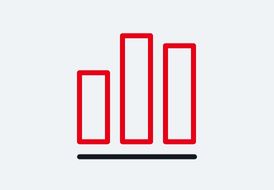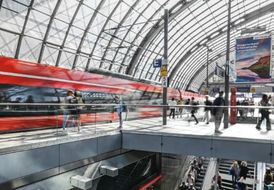Economic climate, market and competition
Demand for our mobility services and, in particular, our transport and logistics services depends, among other things, on overall economic developments:
- Economic growth fuels the trends underlying our strategy in our markets.
- Macroeconomic shocks such as economic and financial crises, disruptions to supply chains or economic downturns resulting from, amongst other things, geopolitical conflicts or epidemics can have a significant negative impact on our business.
- Risks arising from depleted public sector budgets in some European countries could have negative effects (particularly in the form of spending cuts). The market volume is greatly determined by the financial situation of the contracting organizations. However, there is also the potential for new markets or market segments to be opened for competition.
- Developments in the competitive environment are of particular importance for DB Group:
- In long-distance transport, we are primarily exposed to fierce intermodal competition, particularly with motorized individual transport as the dominant competitor, but also with long-distance bus services and aviation.
- In regional transport, there is intense competition throughout Europe for securing long-term transport contracts. This means there is a risk of volume losses. In order to remain competitive in this market, we are constantly working to optimize our tender management and our cost structures. In addition, risks arise from the implementation of transport contracts if the parameters of the underlying calculation do not materialize as planned. In order to continuously increase quality and customer satisfaction and improve our efficiency, we have put together appropriate programs.
- In rail freight transport, there is a high level of competitive pressure. Risks arise from the fact that, to some extent, competitors can operate with less expensive cost structures while enjoying more flexible working conditions. Further risks result from possible future efficiency gains of trucks, for example by digitalization. Several measures are being implemented to tackle these challenges.
- In the freight forwarding business, there is on the one hand intense competition with other providers, and on the other hand a concentration of the market in the carrier sector has brought about a change in the offerings of cargo space with corresponding effects on the purchase and sales prices. We are responding to this by continuously optimizing our networks and improving our cost structures, services and IT infrastructure. The dynamic development of freight rates presents opportunities. A further drop in the extremely high freight rates in air and ocean freight in the last two years would have a significant negative impact on net profit and loss.
Overall, a general risk is a loss of competitiveness. A key component in facing the competition is improvements in service quality. To this end, we are implementing the Strong Rail strategy in the Integrated Rail System and the UNLEASH strategy at DB Schenker.
The trend towards digitalization is creating key opportunities for performance enhancements:
- more efficient and customer-focused processes,
- improved and new digital services, and
- easier access with online portals and apps.
In the medium-term, changes in the competitive environment may result from the following developments:
- New competitors: Providers from outside of the industry, such as automobile manufacturers, IT companies and start-ups, may also become increasingly active in our markets.
- New platforms/data-driven business models: Digital platform providers are increasing the intensity of competition and transparency, and are also changing the perception of prices. Start-ups in particular are the driving force behind the platform business and aim to occupy the digital customer interface.
- Shifts in added value: Added value in the mobility and logistics sector could shift towards additional services.
- Integrated on-demand mobility: Mobility-as-a-Service (MaaS) concepts will be part of the standard offering in the long-term. The customer can order, book and pay for transport easily and in real time.
- Cost pressure on the public sector could increase: Ordering behavior could also change and tenders could expand to include on-demand, minibus and shuttle services. This increases the cost pressure on established providers.
- Supply chain visibility: Transparency in the value-added chain is one of the top trends in logistics. Start-ups and established players see data and analysis solutions as a significant business opportunity.
- Goods structure effect: The production share of highly specialized goods such as pharmaceuticals and high-tech products is growing strongly. At the same time, types of goods with a generally lower weight and higher value density, such as electronic components, are growing at an above-average rate. Heavy, bulky goods, such as steel, paper and chemicals are becoming less important.
In order to adequately counter the resulting opportunities and risks, we are using our digitalization strategy.
We are also responding to opportunities and risks arising from changing demand patterns and from shifts in traffic patterns throughout DB Group with intensive market observation and by continuously upgrading our portfolio and our products.
The demand for our products and services is partly dependent on the development of our customers:
- Our customers’ economic development dictates their need for storage and transport services, which in turn affects our freight forwarding and logistics businesses. In addition, there may be structural changes in the production structures of our customers. The rising costs and risks of globally distributed production make regional production more efficient. Another reason for regionalization is the use of production innovations such as automation, modularization and 3D printing with the potential to relativize wage cost differences and economies of scale.
- Rail freight transport is partly dependent on industries that are stagnating. In addition, disruptions in production or even temporary shutdowns (for example as a result of supply chain disruptions) can result in a drop in customers’ demand for transport services, at least temporarily.
- The development of demand in track infrastructure is dependent on rail transport’s ability to compete on the upstream transport markets.


